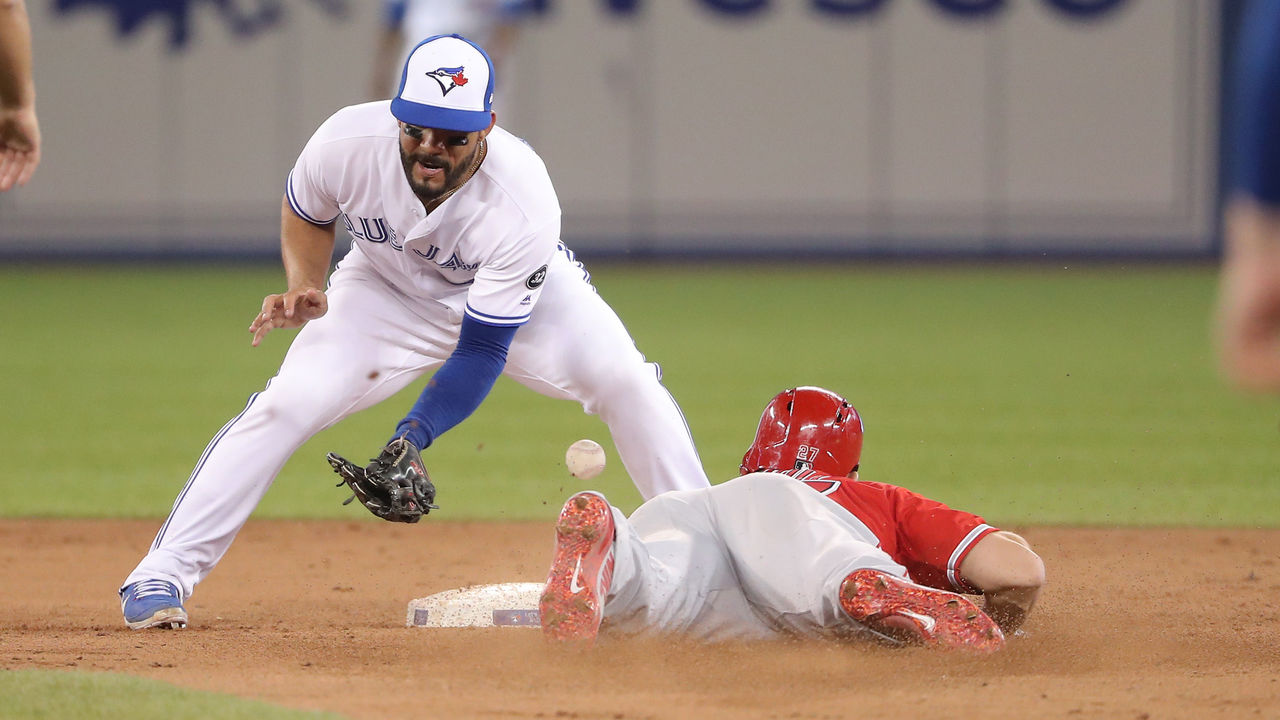The 4 tools that make Mike Trout the greatest player alive
Entering Monday, 21 lineups in Major League Baseball have produced 6.0 or more Wins Above Replacement, according to FanGraphs.
Well, 21 lineups and Mike Trout, who comes into the week at 6.1.
The best player in baseball has singlehandedly produced more value than nine entire lineups, including the Blue Jays, Rangers, Mets, and White Sox. Still just 26, Trout isn’t only chasing a career-best season – he’s pursuing the greatest season in more than 140 years of Major League Baseball.
That honour currently belongs to Babe Ruth, who posted a 15.0 FanGraphs WAR and 14.1 Baseball Reference WAR back in 1923. At Trout’s current pace, stretched across 162 games, he would reach a 13.7 FanGraphs WAR and a 14.4 Baseball Reference WAR. That record, once thought impossible, is suddenly attainable.
Regardless of whether or not he reaches The Babe, though, Trout is doing the unthinkable. He’s improving from a point of what is, relative to baseball terms, perfection.
Still, he’s managed to do it without being boasted for what he is: one of the top professional athletes on the planet. Trout is Serena Williams. He’s LeBron James. He’s Wayne Gretzky. And if he sat next to most fans at a game on a Tuesday night, they might ask, ‘Hey, what do you do for a living?’
There’s no standout style, personality trait, or trademark beard that makes Trout different from the rest. The average fan wouldn’t know the sound of Trout’s voice, either. He is, in so many ways, exceedingly normal.
Baseball is also slow to recognize its legends while they’re still playing. The ‘greatest of all time’ conversation dominates the NBA and NFL news cycles with LeBron and Tom Brady, but in baseball, players that exist only in black-and-white photographs are given a fast pass to the front of the line.
It’s here now, though, begging to be recognized and celebrated and savored. Of the nearly 19,000 players to put on a major-league uniform, only a handful have ever done it as well as Trout. Ten years from now, maybe none have.
Looking inside his historic season, Trout’s remarkable consistency in these four areas has him rounding the corner into a stretch run against history.
The bat

Trout enters this week with a career-high batting average, on-base percentage, slugging percentage, OPS+, and wRC+. Across the board, baseball’s best player has never been better with the bat in his hands.
His line-drive rate of 26.2 percent is another career high, and Trout has never made hard contact more consistently.
These are all prolific numbers, ones that would be jarring if they came from nearly any other player. It’s Trout’s year-to-year consistency, however, that adds a bizarre level of normalcy to the situation. Even his manager isn’t noticing any changes to Trout’s game, outside of the odd tinker.
“I don’t see much different in what Mike’s doing,” Angels manager Mike Scioscia told CBS. “He’s an exceptional talent. He can beat you on the base paths. He can steal a base or take another base. In centre field he’s playing a Gold Glove-calibre centre field. In the batter’s box, he’s the most dangerous player in baseball.”
Trout’s average exit velocity of 93.2 mph is his best mark since Statcast began measuring it four seasons ago, and by avoiding harmless ground balls and pop-ups, Trout is giving himself a chance with nearly every ball put in play. Launch angle has something to do with this, too.
After having average launch angles of 14.1 and 12.9 degrees in 2015 and 2016, that’s spiked up to 18.0 and 18.3 in 2017 and 2018. This is a common trend in Major League Baseball amid the league-wide power surge, but for most players, the added uppercut to their swing comes with poor contact rates and increased strikeouts.
Not Trout. Instead, he’s walking as much as he strikes out and has barrelled up a career-high 18.7 percent of pitches, well above the league average of 6.1 percent. Opposing pitchers can’t get an edge, either. He crushes the fastball, holds his own against breaking balls, and is hitting .419 against offspeed pitches this season.
Often times, “the book is out” on a hitter by the time they reach their eighth Major League season. Trout’s book isn’t for sale yet.
The eye

Trout’s mammoth offensive numbers are all set up by an elite plate approach. He’s well on his way to his fourth consecutive season with a .400+ on-base percentage, but has still managed to make some noticeable adjustments.
On the first pitch of at-bats, Trout is swinging less often than usual and working deeper counts. He’s chased just 17.9 percent of pitches out of the strike zone, well below the league average of 28.2 percent, and doesn’t miss it when it’s over the plate. His 90.1 percent contact rate on pitches inside the zone is a new personal best.
“From a Statcast perspective, what I like about him is that he doesn’t have any weaknesses,” MLB analyst and Statcast specialist Mike Petriello told theScore. “He doesn’t have the best exit velocity or best hard-hit (rate) or best launch angle or anything like that, but he’s so good in so many different things.”
The wheels

Trout isn’t Billy Hamilton or Byron Buxton on the bases, nor should he be. Trout has 75 pounds on Hamilton and 45 on Buxton, built more like a modern-day NFL linebacker than a centre fielder.
He isn’t far off from the league’s best on the bases, though. Statcast has measured the sprint speed of 485 major-league players this season, and Trout is the 23rd fastest with an average speed of 29.2 feet per second.
That number falls in line with his past few seasons, and Trout has constantly been in the 95th percentile of major leaguers when it comes to sprint speed.
These aren’t wasted wheels, either. Trout picks his spots as well as anyone.
Trout may never approach his career high of 49 steals from 2012, when he was 20, but he’s gone a perfect 13-for-13 in 2018. Coming on the heels of a 22-for-26 season on the bases last year, Trout’s maturity is showing in this efficiency. Trout also leads the league in runs scored.
His cumulative baserunning value - wrapped up into BsR, FanGraphs’ all-encompassing baserunning stat - ranks him as tied for being the third-most valuable runner in all of baseball. This accounts for the decisions he makes going from first to third, trying to score on a double from first, and any other on-base situation alongside his stolen base numbers.
The glove

If you squinted hard and really wanted to find it, Trout’s defensive value used to be a rare weak spot in his game. With Trout, of course, a weakness is like a paint chip on a Lamborghini.
Much like Trout’s adjustment to hitting fastballs a few seasons ago, he seems to have recognized that there was room for improvement with his glove and simply snapped his fingers.
“He can just identify things to improve at, and then just do it,” Petriello said. “It’s not fair.”
Statcast has tracked Outs Above Average since 2016, which tallies how many runs a player saves their team defensively. Trout totaled minus-2 and minus-3 in the past two seasons, creating a rare circumstance where you need to actually scroll down a list to find Trout’s name.
This season, that number is already up to plus-4. By all other defensive metrics, including DRS and UZR, Trout is on pace to flirt with that 2012 season, when he burst on the scene and appeared to be a perennial Gold Glove candidate.
In a game of constant adjustments, Trout has the ability to recognize his own flaws before the rest of the league does, and turn them into legitimate strengths before the rest of the league catches up.
Keegan Matheson is the editor-in-chief of Baseball Toronto, which he founded in early 2018 after previously covering the Blue Jays for MLB.com. He appears regularly across sports radio and television networks in Canada as a Blue Jays and MLB analyst. Now living in Toronto, Keegan is originally from Nova Scotia; find him on Twitter @KeeganMatheson.
(Photos courtesy: Getty Images)